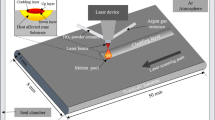Abstract
Bone implants are extensively used in biomedical science for replacement of bone and joint defects, but a variation of stiffness between implant material and bone causes load redistribution around the implant, resulting in autogenous bone fracture or loosening of implant, called stress shielding. To overcome this problem, porous biocompatible titanium alloy (Ti-6Al-4V) is used to reduce the stiffness of metallic implants equivalent to bone stiffness. Ti-6Al-4V is considered to fabricate porous implant scaffold due to its excellent mechanical properties, biocompatible nature, higher corrosion resistance, and high strength-to-weight ratio. Four different porous scaffolds, namely diamond, grid, cross, and vinties, are modeled using Rhino 6 software, where 65% theoretical porosity is maintained. Additive manufacturing (AM) technique, mainly selective laser melting (SLM), is used to fabricate these porous scaffolds. Actual porosity and surface roughness of the fabricated samples are measured. Compression tests of each porous scaffold are performed in INSTRON compressive testing machine. Elastic modulus of fabricated samples shows excellent matching with a human bone, while compressive strength shows superior value compared to the human bone which will help to reduce the stress shielding effect and also will increase the longevity of the implants. The relative elastic modulus (modulus ratio of porous scaffold to solid cube) of the samples is studied using the Gibson–Ashby correlation model. The porous scaffolds made with Ti-6Al-4V have low effective Young’s modulus, excellent compressive strength, and sufficient cell accommodation space to fulfill medical requirements for clinical demands.












Similar content being viewed by others
References
S. Hussaini, T.K. Vaidyanathan, A.P. Wadkar et al., Peri-implant strain in an in vitro model. J. Oral Implantol. 41(5), 532–537 (2015)
Z. Chen, X. Yan, S. Yin et al., Influence of the pore size and porosity of selective laser melted Ti6Al4V ELI porous scaffold on cell proliferation, osteogenesis and bone ingrowth. Mater. Sci. Eng.: C. 106, 110289 (2020)
C. Gao, S. Peng, P. Feng et al., Bone biomaterials and interactions with stem cells. Bone Res. 5(1), 1–33 (2017)
J.D. Currey, The structure and mechanics of bone. J. Mater. Sci. 47(1), 41–54 (2012)
A. Heuijerjans, W. Wilson, K. Ito et al., The critical size of focal articular cartilage defects is associated with strains in the collagen fibers. Clin. Biomech. 1(50), 40–46 (2017)
S. Hoover, S. Tarafder, A. Bandyopadhyay et al., Silver doped resorbabletricalcium phosphate scaffolds for bone graft applications. Mater. Sci. Eng., C 1(79), 763–769 (2017)
X. Liu, P.K. Chu, C. Ding, Surface modification of titanium, titanium alloys, and related materials for biomedical applications. Mater. Sci. Eng. R. Rep. 47(3–4), 49–121 (2004)
S. Liu, Y.C. Shin, Additive manufacturing of Ti6Al4V alloy: A review. Mater. Design. 164, 107552 (2019)
M. Geetha, A.K. Singh, R. Asokamani et al., Ti based biomaterials, the ultimate choice for orthopaedic implants–a review. Prog. Mater Sci. 54(3), 397–425 (2009)
M.V. Martens, R. Van Audekercke, P. Delport et al., The mechanical characteristics of cancellous bone at the upper femoral region. J. Biomech. 16(12), 971–983 (1983)
S. Bose, D. Ke, H. Sahasrabudhe et al., Additive manufacturing of biomaterials. Prog. Mater Sci. 1(93), 45–111 (2018)
J. Parthasarathy, 3D modeling, custom implants and its future perspectives in craniofacial surgery. Annals Maxillofacial Surg. 4(1), 9 (2014)
A.L. Jardini, M.A. Larosa, C.A. deCarvalhoZavaglia et al., Customised titanium implant fabricated in additive manufacturing for craniomaxillofacial surgery. Virtual Phys. Prototyp. 9(2), 115–125 (2014)
F.P. Melchels, J. Feijen, D.W. Grijpma, A review on stereolithography and its applications in biomedical engineering. Biomaterials 31(24), 6121–6130 (2010)
D.E. Cooper, M. Stanford, K.A. Kibble et al., Additive manufacturing for product improvement at Red Bull Technology. Mater. Des. 1(41), 226–230 (2012)
A. Uriondo, M. Esperon-Miguez, S. Perinpanayagam, The present and future of additive manufacturing in the aerospace sector: a review of important aspects. J. Aerosp. Eng. 229(11), 2132–2147 (2015)
C. Weller, R. Kleer, F.T. Piller, Economic implications of 3D printing: market structure models in light of additive manufacturing revisited. Int. J. Prod. Econ. 1, 1–43 (2014)
V. Petrovic, J. Vicente, H. Gonzalez et al., Additive layered manufacturing: sectors of industrial application shown through case studies. Int. J. Prod. Res. 49(4), 1061–1079 (2011)
J.E. Biemond, G. Hannink, N. Verdonschot et al., Bone ingrowth potential of electron beam and selective laser melting produced trabecular-like implant surfaces with and without a biomimetic coating. J. Mater. Sci. Mater. Med. 24(3), 745–753 (2013)
S. Ponader, E. Vairaktaris, P. Heinl et al., Effects of topographical surface modifications of electron beam melted Ti-6Al-4V titanium on human fetal osteoblasts. J. Biomed. Mater. Res., Part A 84(4), 1111–1119 (2008)
B. Gorny, T. Niendorf, J. Lackmann et al., In situ characterization of the deformation and failure behavior of non-stochastic porous structures processed by selective laser melting. Mater. Sci. Eng., A 528(27), 7962–7967 (2011)
L. Le Guehennec, M.A. Lopez-Heredia, B. Enkel et al., Osteoblastic cell behaviour on different titanium implant surfaces. Actabiomaterialia. 4(3), 535–543 (2008)
L. Le Guéhennec, A. Soueidan, P. Layrolle et al., Surface treatments of titanium dental implants for rapid osseointegration. Dent. Mater. 23(7), 844–854 (2007)
M.F. Ashby, L.J. Gibson, Cellular solids structure and properties. Press Synd. Univ. Cambridge: Cambridge, UK. 175–231 (1997)
T. Vilaro, C. Colin, J.D. Bartout, As-fabricated and heat-treated microstructures of the Ti-6Al-4V alloy processed by selective laser melting. Metall. Mater. Trans. A. 42(10), 3190–3199 (2011)
Acknowledgements
The authors acknowledge Khishimoto-Inaba Laboratory of Tokyo Institute of Technology for providing suggestions for experiments and guidance during the preparation of this manuscript.
Funding
The author(s) received no financial support for the research, authorship, and/or publication of this article.
Author information
Authors and Affiliations
Corresponding author
Ethics declarations
Conflict of interest
The author(s) declared no potential conflicts of interest with respect to the research, authorship, and/or publication of this article.
Additional information
Publisher's Note
Springer Nature remains neutral with regard to jurisdictional claims in published maps and institutional affiliations.
Rights and permissions
About this article
Cite this article
Mondal, P., Das, A., Mondal, A. et al. Fabrication of Ti-6Al-4V Porous Scaffolds Using Selective Laser Melting (SLM) and Mechanical Compression Test for Biomedical Applications. J. Inst. Eng. India Ser. D 103, 181–190 (2022). https://doi.org/10.1007/s40033-022-00333-1
Received:
Accepted:
Published:
Issue Date:
DOI: https://doi.org/10.1007/s40033-022-00333-1




